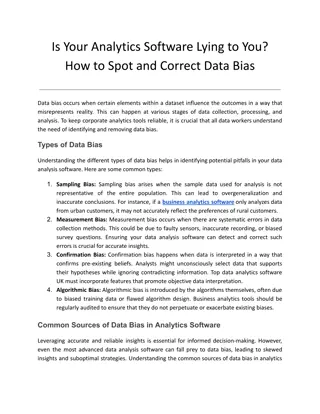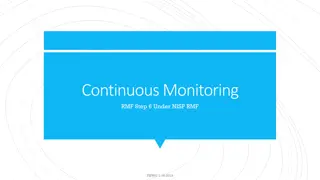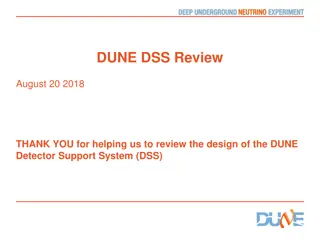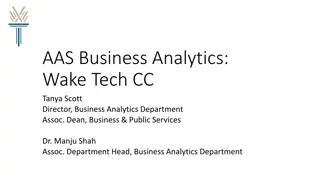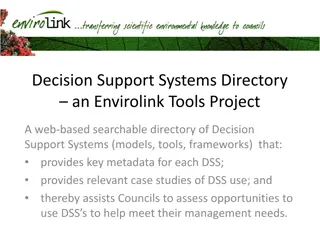
Introduction to Business Decision-Making
Explore the fundamental concepts of decision-making and problem-solving in business intelligence. Learn about different types and levels of decision-making, as well as the role of decision support systems. Dive into the definition and components of decision-making to enhance your understanding of managerial activities and processes within organizations.
Download Presentation

Please find below an Image/Link to download the presentation.
The content on the website is provided AS IS for your information and personal use only. It may not be sold, licensed, or shared on other websites without obtaining consent from the author. If you encounter any issues during the download, it is possible that the publisher has removed the file from their server.
You are allowed to download the files provided on this website for personal or commercial use, subject to the condition that they are used lawfully. All files are the property of their respective owners.
The content on the website is provided AS IS for your information and personal use only. It may not be sold, licensed, or shared on other websites without obtaining consent from the author.
E N D
Presentation Transcript
Business Intelligence: Business Intelligence: Introduction to Introduction to Decision Making & Decision Support Decision Making & Decision Support Prepared by Dr Shuliang Li Prepared by Dr Shuliang Li, FBCS , FBCS
Learning outcomes Learning outcomes Understand the concepts of decision-making and problem solving Understand the different types and different levels of decision-making Understand the definition and functional components of decision support systems
Definition of decision Definition of decision- -making making Decision-making is a process of choosing among alternative courses of action for the purpose of attaining a goal or goals (Turban and Aronson, 2001). According to Simon (1977), The New Science of Management Decision (Prentice Hall, Upper Saddle River, NJ), managerial decision making is synonymous with the whole process of management . Decision-making is the core processes of every business. All managerial activities revolve around decision-making.
The general process of decision The general process of decision- -making (Simon, 1977) (Simon, 1977) making According to According to Simon (1977), The New Science of Management Decision (Prentice Hall, Upper Saddle River, NJ), a systematic decision-making process involves three major phases: Intelligence Design Choice. (Implementation)
Types of Decision Making Type of decision- making Unstructured (non- programmed) Characteristics Example No cut-and-dried solution methods; based mainly on the judgement, experience and intuition of the decision-maker Negotiating; social responsibility planning; Journal cover selection Structured (programmed) Routine and repetitive; there are defined methods for identifying alternatives and evaluating them; standard solution procedures exist Personnel reports; budget analysis Semi-structured Fall between unstructured and structured decision-making problems; solving them involves both standard solution methods and human judgement and intuition Credit evaluation; investment analysis; building new plant; new product planning; strategic planning
Levels of Decision Making Levels of Decision Making Three main levels of decision-making (Chaffey et al, 2003): Strategic level Tactical Level Operational Level
Decision Support Systems Decision Support Systems A decision support system (DSS) is an interactive computer-based information system that combines models and data in an attempt to support managerial decision-makers in semi-structured decision situations (and some unstructured decision situations). Computerized decision support implies the use of computers to: assist managers in their decision-making processes; support, rather than replace, managerial judgement and intuition (Keen and Scott Morton, 1978). The use of decision support systems should focus on improving the effectiveness (e.g. the quality of decisions) of decision-making, rather than merely improving the efficiency.
The basic components of a decision support system The basic components of a decision support system (Sprague and Carlson, 1982), extended by Shuliang (Sprague and Carlson, 1982), extended by Shuliang Li on the data and models. Li on the data and models. Business models, conversion funnel, innovation process, decision support models, online smart bots, artificial intelligence, intelligent systems, decision automation models, etc. Model User Dialog Internet data, Web data, big data, social media analytics, Web analytics, databases, data warehouse, online & offline data, human judgement & intuition, etc. Data
C Componen omponents of a DSS ts of a DSS Dialog (or the user interface): A component or user interface designed for achieving interaction between the system and the user. The dialog should be designed to enable the user to input and access relevant data, formulate models and review results or output of the system Models: A component that provides analysis capabilities or functions such as quantitative models, solution procedures, etc. Data: Data source which includes user-inputted data, internal and external data or information, managerial judgement, etc. More components such as data management subsystem including social media analytics & Web analytics; model management subsystem; knowledge-based subsystem & artificial intelligence; user interface subsystem; and the user. (Li, 2000, 2010, 2011)
Strengths of a DSS: Utilizing models and data to support semi- structured (and some unstructured) decision- making problems Weaknesses of a DSS: Mainly quantitative; limited to the models used; Inability to handle missing data (Li et al, 2000)







